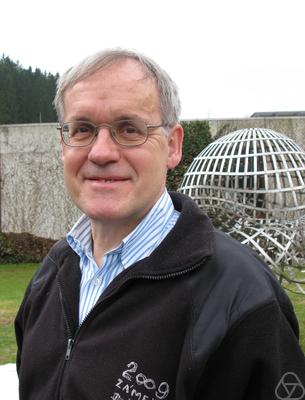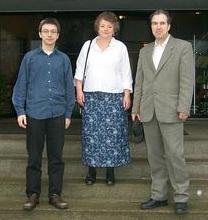|
Graver Basis
In applied mathematics, Graver bases enable iterative solutions of linear and various nonlinear integer programming problems in polynomial time. They were introduced by Jack E. Graver.Jack E. Graver: On the foundations of linear and linear integer programming, Mathematical Programming 9:207–226, 1975 Their connection to the theory of Gröbner bases was discussed by Bernd Sturmfels.Bernd Sturmfels, ''Gröbner Bases and Convex Polytopes'', American Mathematical Society, xii+162 pp., 1996 The algorithmic theory of Graver bases and its application to integer programming is described by Shmuel Onn.Shmuel onn |
Applied Mathematics
Applied mathematics is the application of mathematical methods by different fields such as physics, engineering, medicine, biology, finance, business, computer science, and industry. Thus, applied mathematics is a combination of mathematical science and specialized knowledge. The term "applied mathematics" also describes the professional specialty in which mathematicians work on practical problems by formulating and studying mathematical models. In the past, practical applications have motivated the development of mathematical theories, which then became the subject of study in pure mathematics where abstract concepts are studied for their own sake. The activity of applied mathematics is thus intimately connected with research in pure mathematics. History Historically, applied mathematics consisted principally of applied analysis, most notably differential equations; approximation theory (broadly construed, to include representations, asymptotic methods, variational ... [...More Info...] [...Related Items...] OR: [Wikipedia] [Google] [Baidu] |
Alexander Schrijver
Alexander (Lex) Schrijver (born 4 May 1948 in Amsterdam) is a Dutch mathematician and computer scientist, a professor of discrete mathematics and optimization at the University of Amsterdam and a fellow at the Centrum Wiskunde & Informatica in Amsterdam.Profile CWI, retrieved 2012-03-30. Since 1993 he has been co-editor in chief of the journal ''''.''Combinatorica'' journal home page Springer, retrieved 2012-03-30. Biography Schrijver earned his Ph.D. in 1977 from the |
Parameterized Complexity
In computer science, parameterized complexity is a branch of computational complexity theory that focuses on classifying computational problems according to their inherent difficulty with respect to ''multiple'' parameters of the input or output. The complexity of a problem is then measured as a function of those parameters. This allows the classification of NP-hard problems on a finer scale than in the classical setting, where the complexity of a problem is only measured as a function of the number of bits in the input. The first systematic work on parameterized complexity was done by . Under the assumption that P ≠ NP, there exist many natural problems that require superpolynomial running time when complexity is measured in terms of the input size only, but that are computable in a time that is polynomial in the input size and exponential or worse in a parameter . Hence, if is fixed at a small value and the growth of the function over is relatively small then such p ... [...More Info...] [...Related Items...] OR: [Wikipedia] [Google] [Baidu] |
Linear Programming Relaxation
In mathematics, the relaxation of a (mixed) integer linear program is the problem that arises by removing the integrality constraint of each variable. For example, in a 0–1 integer program, all constraints are of the form :x_i\in\. The relaxation of the original integer program instead uses a collection of linear constraints :0 \le x_i \le 1. The resulting relaxation is a linear program, hence the name. This relaxation technique transforms an NP-hard optimization problem (integer programming) into a related problem that is solvable in polynomial time (linear programming); the solution to the relaxed linear program can be used to gain information about the solution to the original integer program. Example Consider the set cover problem, the linear programming relaxation of which was first considered by . In this problem, one is given as input a family of sets ''F'' = ; the task is to find a subfamily, with as few sets as possible, having the same union as ''F''. To formulate ... [...More Info...] [...Related Items...] OR: [Wikipedia] [Google] [Baidu] |
Multi-commodity Flow Problem
The multi-commodity flow problem is a network flow problem with multiple commodities (flow demands) between different source and sink nodes. Definition Given a flow network \,G(V,E), where edge (u,v) \in E has capacity \,c(u,v). There are \,k commodities K_1,K_2,\dots,K_k, defined by \,K_i=(s_i,t_i,d_i), where \,s_i and \,t_i is the source and sink of commodity \,i, and \,d_i is its demand. The variable \,f_i(u,v) defines the fraction of flow \,i along edge \,(u,v), where \,f_i(u,v) \in ,1/math> in case the flow can be split among multiple paths, and \,f_i(u,v) \in \ otherwise (i.e. "single path routing"). Find an assignment of all flow variables which satisfies the following four constraints: (1) Link capacity: The sum of all flows routed over a link does not exceed its capacity. :\forall (u,v)\in E:\,\sum_^ f_i(u,v)\cdot d_i \leq c(u,v) (2) Flow conservation on transit nodes: The amount of a flow entering an intermediate node u is the same that exits the node. :\forall i \in K: ... [...More Info...] [...Related Items...] OR: [Wikipedia] [Google] [Baidu] |
Statistical Database
A statistical database is a database used for statistical analysis purposes. It is an OLAP (online analytical processing), instead of OLTP (online transaction processing) system. Modern decision, and classical statistical databases are often closer to the relational model than the multidimensional model commonly used in OLAP systems today. Statistical databases typically contain parameter data and the measured data for these parameters. For example, parameter data consists of the different values for varying conditions in an experiment (e.g., temperature, time). The measured data (or variables) are the measurements taken in the experiment under these varying conditions. Many statistical databases are sparse with many null or zero values. It is not uncommon for a statistical database to be 40% to 50% sparse. There are two options for dealing with the sparseness: (1) leave the null values in there and use compression techniques to squeeze them out or (2) remove the entries that on ... [...More Info...] [...Related Items...] OR: [Wikipedia] [Google] [Baidu] |
Jesús A
Jesus ( AD 30 or 33) was a Jewish preacher and religious leader who most Christians believe to be the incarnation of God and Muslims believe was a prophet. Jesus may also refer to: People Religious figures * Elymas Bar-Jesus, a Jew in the ''Acts of the Apostles'', chapter 13, who opposed the missionary Paul on Cyprus * Jesus Barabbas (Matthew 27:16–17 margin), pardoned criminal * Jesus Justus (Colossians 4:11), Christian in Rome mentioned by Paul Other people with the name * Jesus (name), as given name and surname, derived from the Latin name ''Iesus'' and the Greek ('). * Jesus ben Ananias (died ), Jewish nationalist mentioned by Josephus * Jesus Ben Sira (), religious writer, author of the Book of Sirach * Jesus Christ Allin or GG Allin (1956–1993), American punk rock musician * Jesús González Díaz (born 1994), simply known as Jesús, Spanish footballer * Jesús Malverde, legendary Mexican bandit-saint * Jesús Rodríguez (other) * Gabriel Jesus (born 199 ... [...More Info...] [...Related Items...] OR: [Wikipedia] [Google] [Baidu] |
Totally Unimodular
In mathematics, a unimodular matrix ''M'' is a square integer matrix having determinant +1 or −1. Equivalently, it is an integer matrix that is invertible over the integers: there is an integer matrix ''N'' that is its inverse (these are equivalent under Cramer's rule). Thus every equation , where ''M'' and ''b'' both have integer components and ''M'' is unimodular, has an integer solution. The ''n'' × ''n'' unimodular matrices form a group called the ''n'' × ''n'' general linear group over \mathbb, which is denoted \operatorname_n(\mathbb). Examples of unimodular matrices Unimodular matrices form a subgroup of the general linear group under matrix multiplication, i.e. the following matrices are unimodular: * Identity matrix * The inverse of a unimodular matrix * The product of two unimodular matrices Other examples include: * Pascal matrices * Permutation matrices * the three transformation matrices in the ternary tree of primitive Pythagorean ... [...More Info...] [...Related Items...] OR: [Wikipedia] [Google] [Baidu] |
Hilbert's 10th Problem
Hilbert's tenth problem is the tenth on the list of mathematical problems that the German mathematician David Hilbert posed in 1900. It is the challenge to provide a general algorithm which, for any given Diophantine equation (a polynomial equation with integer coefficients and a finite number of unknowns), can decide whether the equation has a solution with all unknowns taking integer values. For example, the Diophantine equation 3x^2-2xy-y^2z-7=0 has an integer solution: x=1,\ y=2,\ z=-2. By contrast, the Diophantine equation x^2+y^2+1=0 has no such solution. Hilbert's tenth problem has been solved, and it has a negative answer: such a general algorithm does not exist. This is the result of combined work of Martin Davis, Yuri Matiyasevich, Hilary Putnam and Julia Robinson which spans 21 years, with Matiyasevich completing the theorem in 1970. The theorem is now known as Matiyasevich's theorem or the MRDP theorem (an initialism for the surnames of the four principal contributor ... [...More Info...] [...Related Items...] OR: [Wikipedia] [Google] [Baidu] |
Integer Programming
An integer programming problem is a mathematical optimization or Constraint satisfaction problem, feasibility program in which some or all of the variables are restricted to be integers. In many settings the term refers to integer linear programming (ILP), in which the objective function and the constraints (other than the integer constraints) are Linear function (calculus), linear. Integer programming is NP-complete. In particular, the special case of 0-1 integer linear programming, in which unknowns are binary, and only the restrictions must be satisfied, is one of Karp's 21 NP-complete problems. If some decision variables are not discrete, the problem is known as a mixed-integer programming problem. Canonical and standard form for ILPs In integer linear programming, the ''canonical form'' is distinct from the ''standard form''. An integer linear program in canonical form is expressed thus (note that it is the \mathbf vector which is to be decided): : \begin & \text && \math ... [...More Info...] [...Related Items...] OR: [Wikipedia] [Google] [Baidu] |
Integer Programming
An integer programming problem is a mathematical optimization or Constraint satisfaction problem, feasibility program in which some or all of the variables are restricted to be integers. In many settings the term refers to integer linear programming (ILP), in which the objective function and the constraints (other than the integer constraints) are Linear function (calculus), linear. Integer programming is NP-complete. In particular, the special case of 0-1 integer linear programming, in which unknowns are binary, and only the restrictions must be satisfied, is one of Karp's 21 NP-complete problems. If some decision variables are not discrete, the problem is known as a mixed-integer programming problem. Canonical and standard form for ILPs In integer linear programming, the ''canonical form'' is distinct from the ''standard form''. An integer linear program in canonical form is expressed thus (note that it is the \mathbf vector which is to be decided): : \begin & \text && \math ... [...More Info...] [...Related Items...] OR: [Wikipedia] [Google] [Baidu] |
Mathematical Sciences Research Institute
The Simons Laufer Mathematical Sciences Institute (SLMath), formerly the Mathematical Sciences Research Institute (MSRI), is an independent nonprofit mathematical research institution on the University of California campus in Berkeley, California. It is widely regarded as a world leading mathematical center for collaborative research, drawing thousands of leading researchers from around the world each year. The institute was founded in 1982, and its funding sources include the National Science Foundation, private foundations, corporations, and more than 90 universities and institutions. The institute is located at 17 Gauss Way on the Berkeley campus, close to Grizzly Peak in the Berkeley Hills. Because of its contribution to the nation's scientific potential, SLMath's activity is supported by the National Science Foundation and the National Security Agency. Private individuals, foundations, and nearly 100 Academic Sponsor Institutions, including the top mathematics departm ... [...More Info...] [...Related Items...] OR: [Wikipedia] [Google] [Baidu] |


